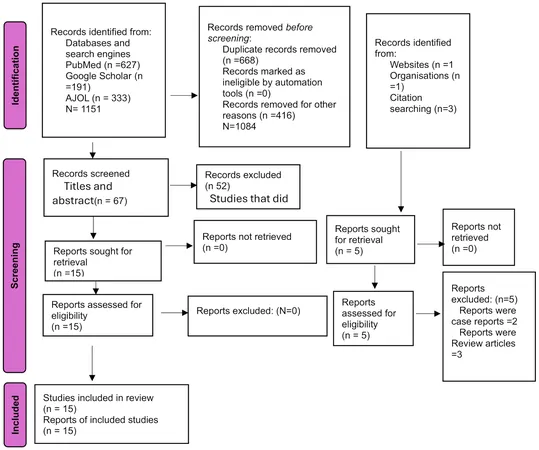
Uncovering the Link Between Cervicovaginal Microbiota and Cervical Cancer Risk in Sub-Saharan Africa: A Comprehensive Review
2025-04-04
Author: Nur
Introduction
Cervical cancer continues to pose a significant threat to women's health in Sub-Saharan Africa, where the burden of this disease is alarmingly high. Recent research highlights the crucial role that cervicovaginal microbiota might play as a risk factor for developing cervical cancer. This article delves into the findings of a systematic review and meta-analysis that aims to shed light on this vital association, all while emphasizing the necessity for integrated health strategies.
Objective of the Research
The primary goal of this systematic review was to evaluate the relationship between cervicovaginal microbiota and cervical cancer in Sub-Saharan Africa. This region experiences the highest incidence and mortality rates from cervical cancer globally, making it imperative to identify pinpointed risk factors.
Research Methodology
To conduct the systematic review and meta-analysis, researchers accessed databases such as PubMed, African Journal Online (AJOL), and Google Scholar. They screened a total of 1,151 articles, ultimately qualifying 15 studies that met strict inclusion criteria focused on cervicovaginal microbiota, cervical cancer, and associated risk factors. The Joanna Briggs Institute (JBI) quality assessment tool was employed to evaluate the methodological rigor of included studies. Statistical analysis was performed using MedCalc software, applying random effects models to address the variability across studies.
Key Findings
The review uncovered significant associations between specific cervicovaginal microbes and cervical cancer, with serious implications for public health in Sub-Saharan Africa. Among the identified risk factors were high-risk human papillomavirus (hrHPV), HIV, and other microorganisms such as Trichomonas vaginalis, Porphyromonas, and Prevotella. Notably, the pooled prevalence of HPV was found to be 40%, significantly higher than the global average, indicating a pressing public health concern. The prevalence of HIV among cervical cancer patients was reported at 19%, aligning with the HIV epidemic's critical impact in this region.
An intriguing aspect of the findings was the high levels of heterogeneity in results across included studies, suggesting substantial differences in study design and population characteristics. However, the quality assessment affirmed that the reviewed articles maintained high standards, reinforcing the study's credibility.
Broader Context: Cervical Cancer in Sub-Saharan Africa
Around the globe, cervical cancer ranks as the fourth most prevalent cancer among women, with approximately 604,000 new cases reported in 2020 alone. In Sub-Saharan Africa, the incidence is even more alarming. The World Health Organization reports that 85% of cervical cancer deaths occur in developing nations, primarily due to a lack of adequate screening and preventive measures.
The ramifications of cervicovaginal microbiota on cervical cancer risk extend beyond mere statistics. Studies indicate that the composition of healthy cervicovaginal microbiota, predominantly featuring Lactobacillus species, is drastically altered in cancer patients. The loss of this beneficial microbiota may pave the way for pathogenic species to thrive and contribute to cancer progression.
Future Directions
The findings of this review underline the urgent need for palpable actions to reduce cervical cancer burden in Sub-Saharan Africa. Integrating microbiota management, enhancing cervical cancer screening and treatment accessibility, and boosting HPV vaccination initiatives will be paramount. Furthermore, longitudinal studies are crucial to unraveling the temporal changes in cervicovaginal microbiota and their potential influence on cancer development.
In conclusion, addressing the intersection of cervicovaginal microbiota, HPV, and HIV in cervical cancer prevention strategies could lead to significant improvements in women's health outcomes in under-resourced settings. The path forward necessitates a collaborative effort among healthcare providers, public health officials, and communities to tackle this looming health crisis head-on.
Call to Action
With the stakes this high, will we rise to the challenge and revolutionize cervical cancer prevention for women in Sub-Saharan Africa? Now is the time to push for integrated health solutions—let's work together to change the narrative!




 Brasil (PT)
Brasil (PT)
 Canada (EN)
Canada (EN)
 Chile (ES)
Chile (ES)
 Česko (CS)
Česko (CS)
 대한민국 (KO)
대한민국 (KO)
 España (ES)
España (ES)
 France (FR)
France (FR)
 Hong Kong (EN)
Hong Kong (EN)
 Italia (IT)
Italia (IT)
 日本 (JA)
日本 (JA)
 Magyarország (HU)
Magyarország (HU)
 Norge (NO)
Norge (NO)
 Polska (PL)
Polska (PL)
 Schweiz (DE)
Schweiz (DE)
 Singapore (EN)
Singapore (EN)
 Sverige (SV)
Sverige (SV)
 Suomi (FI)
Suomi (FI)
 Türkiye (TR)
Türkiye (TR)
 الإمارات العربية المتحدة (AR)
الإمارات العربية المتحدة (AR)